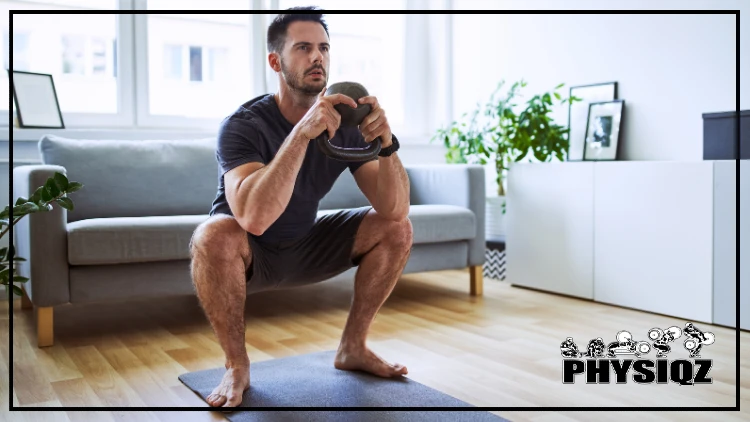
If you’re wondering if you have bad leg genetics, you can do the bodybuilding genetics insertion test to truly figure this out.1
In essence, this test is where you compare your calve and quad insertions against the pictures below to truly determine if your leg genetics have put you at a disadvantage.
However, don’t be discouraged if you do have crappy leg genetics because it’s the cards you were dealt, and while it may be more difficult to grow those pesky quads and calves, and they may not always look absolutely perfect, they don’t have to stop you from making progress.
That being said, we’ll also show lifters with subpar leg genetics exactly how to grow them through a combination of adequate volume and intensity techniques that are proven in the bodybuilding community.
What Is Considered Bad Leg Genetics?
For starters, it’s necessary to get into the anatomy of the legs. There are two major calf muscles – the soleus and the gastrocnemius (the two most visible heads known as lateral head and medial head).
The soleus is mostly hidden underneath the gastrocnemius, except for where it peeks out toward the ankle. This leaves the gastrocnemius as the biggest and most visible calf muscle, the one that bulges out from behind the knee and downward.
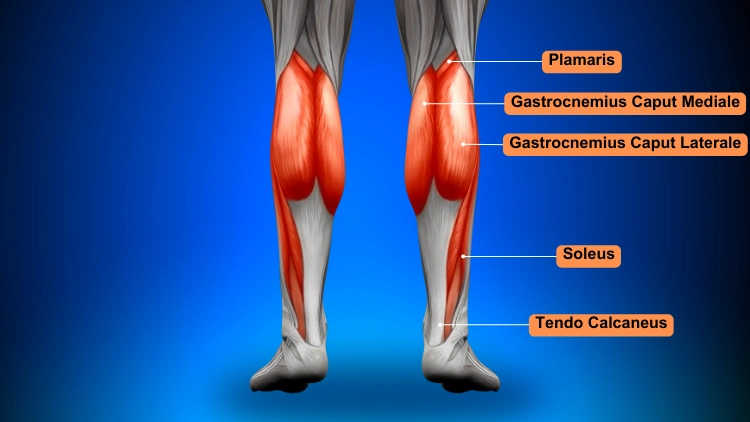
decade3d via Canva.com2
On the other hand, there are four muscles that make up the quads. First is the rectus femoris, which is to the front of the upper leg.
The three vastus muscles, the vastus intermedialis, vastus medialis, and vastus lateralis run to either side of or beneath the rectus femoris. The vastus lateralis makes up the outer thigh, and together with the rectus femoris it’s among the more visible quad muscles.

janulla via Canva.com3
There are three key concepts that make up what it means to have poor leg genetics for bodybuilding. The most obvious and visible point is leg insertions, the factor that determines how long the major leg muscles are.
This contributes to the size of the muscle belly and the shape of the muscle, which is the second factor. The final factor is the ratio of slow twitch, type I muscle fibers to fast-twitch, type II muscle fibers.
To recap, poor leg genetics is generally characterized by:
- High Insertions
- Short muscle bellies
- A high ratio of slow-twitch to fast-twitch muscles
Leg Insertions & Muscle Bellies: Good vs Poor Leg Genetics
First of all, the most important leg insertion is the gastrocnemius. The insertion starts behind the knee and can end anywhere from one-third to two-thirds of the way down to the ankle.
The lower the insertion and the longer the muscle, the thicker the muscle belly.
This would be a good, low insertion, while a high insertion results in a more lopsided bulge and skinny lower calves.
Muscle bellies are the visible curves that people associate with strong, well-developed muscles. A longer muscle insertion and thicker muscle belly mean that a muscle will look larger and more appealing.
The effect on performance and the potential of building strength is not very significant, but it does play a permanent role in aesthetics. A more minor consideration is how the body stores fat; some people’s bodies are more inclined to store fat in the tissue around the gastrocnemius.
This contributes to the illusion of a larger muscle, although not so much as the insertion points.
If a person with high insertions works their calves, the muscle can bulge further outward but will never expand downward toward their ankles, which will remain skinny. However, the composition of slow twitch muscle fibers actually can make it harder to grow the muscle.
There are two types of muscle fibers in the body, and the gastrocnemius has a unique composition of muscle fibers that’s unusually resistant to growth.
How Muscle Fibers Determine Muscle Growth & Performance
Human muscle fibers are a complex, multifaceted area of anatomy with huge ramifications for a person’s performance.4 Each fiber expresses the characteristics of Type I muscle fibers (slow twitch muscle fibers), Type II muscle fibers (fast twitch muscle fibers), or a combination of both.
Type I muscle fibers have incredible endurance but are difficult to push into hypertrophy, while Type II muscle fibers grow much more easily.
The exact ratio of fibers in a muscle varies from muscle to muscle, also and from person to person based on genetics. Whether a person’s leg genetics are ideal for bodybuilding or not, though, the soleus and gastrocnemius have astronomical levels of Type I muscle fibers.5
The gastrocnemius typically consists of around 50% Type I muscle fibers, and the soleus clocks in at 73%.
Studies have shown that elite powerlifters and bodybuilders have naturally high levels of Type II muscle fibers, while world-class endurance athletes have more Type I muscle fibers. This is an important facet of leg genetics and muscle genetics in general, but it’s not something a person can test easily or cheaply.
Plus, the genetic factor is significant, but it’s still smaller than the value of training. It makes a decisive difference at the highest levels because these people are pushing themselves as hard as they can go. Below that level, effort can always compensate for genetics.
What Do Poor Leg Genetics Look Like?
There are many different ways that legs can look with poor genetics. Ironically, legs with very little muscular development will look similar regardless of genetic quality.
It takes some muscle growth to make differences like insertions and muscle bellies obvious, and to expose the signs of bad genetics.
Poor Calf Genetics
An unusually high proportion of Type I muscle fibers can result in calves being small, but it’s hard to prove whether that’s genetics or poor training. Also, take note of the impact of your genetics on your squat form to understand how much genetics influence performance.
Petite Calves
Many people can grow quads but seem to find that their calves remain small.

Source: ryanmurdochfit on TikTok6
This looks like small muscle bellies for the calves, potentially because of a higher proportion of Type I slow twitch muscle fibers.
Thick Upper Calf, Skinny Lower Calf or Ankle
The thing is, a person can have decent size calves, but everything below the calf muscle is tiny and makes it look disproportionate. It’s essentially the opposite of kankles where someone has okay calves, but the diameter around their achilles is small because

Ibrakovic via Canva.com7
In contrast, Jelle Starreveld has unusually low calf insertions mean that even though he may not be able to leg press more than a ton how Ronnie Coleman could, his calves round further down the leg and have a fuller appearance.
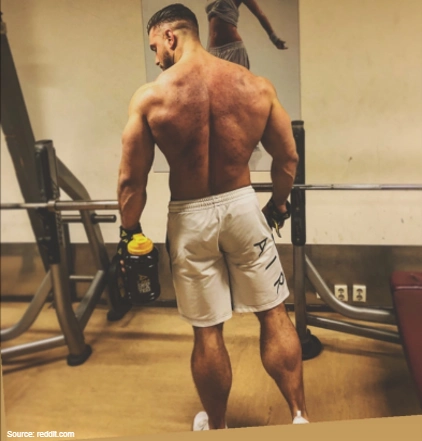
Take note of how his calf muscles go down his leg much further than the picture above. Source: u/porkyishly on Reddit8
Poor Quad Genetics
Overall, poor quad genetics have the same calling cards as poor calf genetics. They might not respond as well to training, and training might reveal unusually high quad insertions.
High Quad Insertions
While these quads are quite well-developed, the insertions are quite high. This is why the muscle stops well above the knee and then turns sharply inward, instead of sloping down closer to the knee.
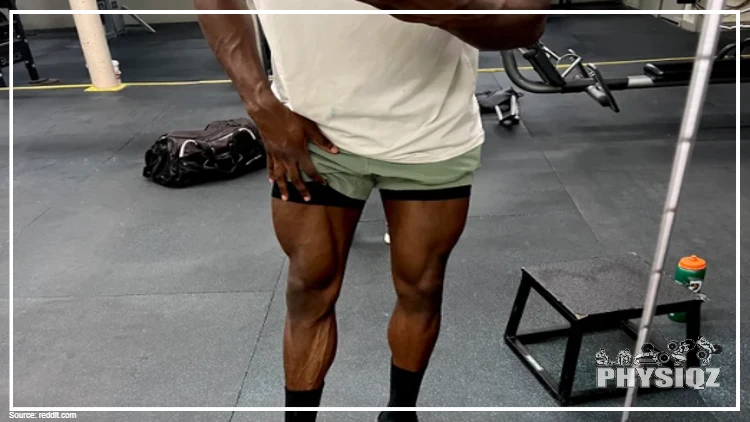
Source: u/themodernronin on Reddit9
The following picture is an example of lower quad insertions:
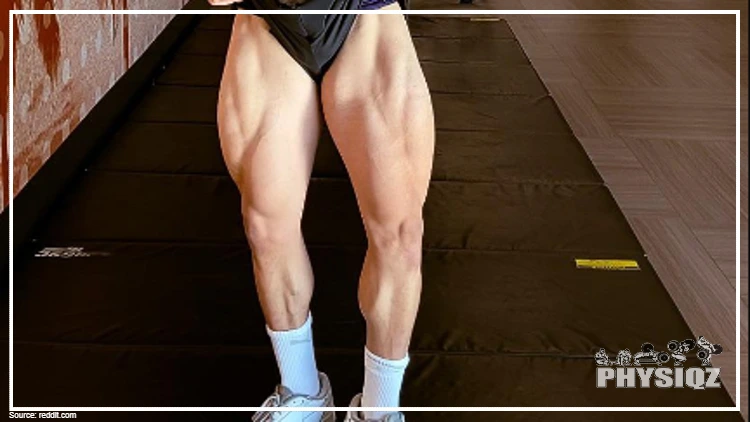
Source: u/Supremegene on Reddit10
How Do I Know If I Have Bad Leg Genetics? Test Your Leg Insertions With This Method
Comparing a person’s leg insertions to the pictures above is a good way to gauge how good they are. However, it might be hard to tell where the insertions are if the muscles are smaller. This simple method.
Start at a full stretch at the bottom, and pause for a second while pulling down further with the tibiae. Push up onto tippy toes and hold for one second, and that should flex the muscles enough to make the insertions clear and visible.
Effective Strategies for Growing Calves Despite Genetic Challenges
It’s easy to feel like others have won the genetic lottery when it comes to their legs, but no one should give up. With hard work, anyone can achieve calf growth.
That said, the high daily burdens the calf takes and its high proportion of slow-twitch muscle fibers mean that it really will be hard work building impressive calves.
Even if a person isn’t very active, their calves are hard-working muscles that carry a large part of the burden when they walk. One way to think of it is that each step a person takes is a repetition of an exercise that works the legs; there’s no need to do the math to know that adds up to some insane volume (weight pushed throughout a period of time).
The leg muscles demand high intensity and advanced training techniques to grow, especially the calves. If a person is consuming enough protein to support hypertrophy and getting enough rest, then the following guidelines are key to building impressive calves.11
Create An Optimized Training Program
Training twice a week is optimal to induce hypertrophy for any muscle group, and calves aren’t any different. Many people don’t deliberately target their calves at all, even if they hit them with compound exercises such as back squats.
If a person already does compound exercises that work the calves, adding six to nine weekly sets of exercises that isolate the calves is a good starting point. If not, a person should add a leg day routine to their workout that incorporates compound exercises like squats as well as calf-isolating exercises.
To help continuously achieve and maintain gains, the training program should incorporate periodization. This means changing weight and rep ranges, going for high reps and more sets in one workout and higher weight in another.
Traditional periodization involves weeks-long cycles of performing the same number of sets and reps before moving to a new period. A more interesting alternative is daily undulating periodization, which involves emphasizing different weights and rep ranges within the same workout.
Studies show that light and heavy exercises are both suitable for strengthening Type I muscle fibers, which underlines how valuable it is to vary up a training regimen.12
Candidate exercises to build calves include:
- Barbell Squats
- Walking Barbell Lunges
- Leg Press
- Leg Extensions
- Seated Leg Curls
- Seated Calf Raises
- Standing Calf Raises
Proper Form & Technique For Calf Development
One common mistake in virtually all exercises is performing them too quickly and dynamically. Whether it’s a dumbbell curl or a seated calf raise, shooting off rapid-fire repetitions will rob the muscles of some of the work they should be doing.
Slow, deep motions with pauses at the point of maximum extension are always necessary to get the most out of a workout, and this is doubly true with the calves.
Short, snappy executions of repetitions for leg exercises will fail to produce calf gains for two reasons. For one, it puts more pressure on the Achilles tendon and its reflex motion, which means that the calf muscle is doing less work.
Secondly, quick and snappy motions are what the calves are already extremely well-trained at because that’s exactly what walking is.
Achieving hypertrophy isn’t just about piling on the weight, but about challenging the muscles in new and different ways. This is why slow, controlled motions are so much better for growing calves.
It makes sure that the calves experience more tension, both as a portion of the exercise and in total, but it also exposes the calves to a new type of stimulation. Changing up the stimuli and challenges that a person puts their muscles through is a reliable way to break through a plateau and stimulate hypertrophy.
Intensity Techniques to Challenge the Calf
There are a variety of ways to challenge a muscle more besides adding on greater weight or reps. These intensity techniques are suitable ways to help push the calves to become larger and stronger:
Drop Sets: Push within a couple of repetitions of failure, and then drop the weight by about 20% and complete as many repetitions as possible before muscle failure.
Super Sets: It’s typical to pause and rest for thirty seconds to several minutes after completing an exercise. With supersets, a person will skip the rest and simply alternate between sets of two different exercises. This allows some recovery but increases the demands on the body overall.
Rest-Pause Reps: Take short rests of about 15 seconds when near muscle failure, perform more reps and repeat.
Partial Reps: After completing the last reps of an exercise, go part-way through the motion several more times to push further and challenge the muscles more.
Other than poor leg genetics, people wonder about all sorts of bad muscle genetics, such as:
In relation to bodily genetics, when a person feels like they’ve lost the genetic lottery, it can be hard to find the motivation to train. However, even when the leg genetics test shows a person has bad leg genetics, hard work can still overcome that limit and produce strong, impressive calves.
Frequently Asked Questions
Are Small Calves or No Calves a Sign of Bad Leg Genetics?
Small calves, high calves, skinny ankles, etc. aren’t necessarily signs of bad calf genetics. In most cases, they’re a sign of undertraining. A person can test their leg insertions to see if they have bad calf genetics, or if they just need a more effective program to build them.
Do I Have Skinny Calves Because of Small Calf Syndrome?
Even calves with high insertions and larger levels of slow-twitch muscle fibers can become quite large. The key is hitting the legs with enough volume and intensity to push them beyond the sizable burdens they already carry.
Are Fat Calves Genetic?
Genetics decides where a person’s body deposits fat, but anyone can eliminate excess fat deposits through weight loss.
Which Leg Insertions Are Better for Bodybuilding?
Longer leg insertions are considered better for bodybuilding. That means quad muscles that stretch closer to the knees, and calf insertions that come closer to the ankles.
References
1BartekSzewczyk. Canva. Accessed 18 April 2023. <https://www.canva.com/photos/MAEUsZGyru0-man-exercising-at-home-doing-kettlebell-squat-in-living-room/>
2decade3d. Canva, Accessed 5 April 2023. <https://www.canva.com/photos/MAC_U2yFahk-calves-anatomy-muscles/>
3Janulla. Canva, Accessed 5 April 2023. <https://www.canva.com/photos/MADE-Sq7uLk-quadriceps-female-anatomy/>
4Plotkin, D. L. (2021, September). Muscle Fiber Type Transitions with Exercise Training: Shifting Perspectives. NCBI. Accessed December 1st, 2022 from <https://www.ncbi.nlm.nih.gov/pmc/articles/PMC8473039/>
5Edgerton, V. R. (1975, May). Muscle fibre type populations of human leg muscles. NCBI. Accessed December 1st, 2022 from <https://pubmed.ncbi.nlm.nih.gov/123895/>
6Stokes, T. (2018, February). Recent Perspectives Regarding the Role of Dietary Protein for the Promotion of Muscle Hypertrophy with Resistance Exercise Training. NCBI. Accessed December 1st, 2022 from <https://www.ncbi.nlm.nih.gov/pmc/articles/PMC5852756/>
7Ibrakovic. Canva, Accessed 5 April 2023. <https://www.canva.com/photos/MADBS3OrCT0-training-strong-legs-calf/>
8Rice, Damien, and Matt Galbraith. Reddit, 16 November 2008, Accessed 5 April 2023. <https://www.reddit.com/r/MensMuscleCalves/comments/arox5r/jelle_starreveld/>
9u/themodernronin. “High quad insertions might be the worst 🙁 : r/strength_training.” Reddit, 9 September 2022, Accessed 5 April 2023. <https://www.reddit.com/r/strength_training/comments/xa2776/high_quad_insertions_might_be_the_worst/>
10u/Supremegene_ 1. “Quads starting to come in, 8 weeks out from my next show. : r/bodybuilding.” Reddit, 15 October 2021, Accessed 5 April 2023. <https://www.reddit.com/r/bodybuilding/comments/q8t77j/quads_starting_to_come_in_8_weeks_out_from_my/>
11Schoenfeld, B. J. (2020, April). Do the anatomical and physiological properties of a muscle determine its adaptive response to different loading protocols? NCBI. Accessed December 1st, 2022 from <https://www.ncbi.nlm.nih.gov/pmc/articles/PMC7186566/>
12Ryan Murdoch. “@ryanmurdochfit.” TikTok, Accessed 5 April 2023. <https://www.tiktok.com/@ryanmurdochfit>